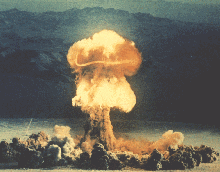
Health in French Polynesia- The Effects of French Nuclear Testing
The following information has been supplied to PlaNet Canterbury from International Physicians for the Prevention of Nuclear War(IPPNW)Australia. It comments on the possible impacts of nuclear testing on the health of French Polynesians.The report was conducted by a Mdecins Sans Frontires scientific team and released in July 1995.The review of that report is an English translation plus some adaptations of an article published in the Le Monde newspaper as drafted by Brigette Visset.
Health in French Polynesia:
Although the French authorities affirm that they monitor closely the effects of their nuclear testing programme on the environment, they have made no effort to monitor the possible medical effects on the population of Polynesia. In early July 1995, a team from the international relief agency Mdecins Sans Frontires (MSF) carried out an evaluation mission in French Polynesia. The Territory has a population of about 200,000.
The MSF team found that the general health of the Polynesian population, as well as the level of care to which they have access, have evolved over the past 30 years in a manner consistent with the socio- economic development of the Territory. The team was particularly concerned with the possible medical effects of exposure to nuclear radiation. MSF examined information available for two populations: the estimated 8,000 to 13,000 Polynesians who have worked at the sites of Moruroa and Fangataufa since the setting up of the nuclear testing programme; and the estimated 1,100 inhabitants of Tureia Island and the Gambier group, who were almost certainly exposed during the period of atmospheric testing.
The team did not meet any major obstacles from the authorities. In spite of this cooperation, however, it was not possible to gather the relevant epidemiological information. This was because certain raw data, as well as the analyses of these data, currently do not exist either in the Territory or in metropolitan France.
Notably:
- Cancer statistics. The official cancer register of French Polynesia only exists since 30 May 1985. Before that date, no reliable figures for cancer incidence were kept. Even as late as 1988, the Public Health Department of the Ministry of Health in Papeete estimated that the sensitivity of the register was quite low: only 60% of cancers were being recorded. Moreover, death certificates only became compulsory after 1981 and the cause of death is not always certified by a doctor. In summary, therefore, no-one has ever studied the number of cancers occurring in the Territory before 1985, and even since then, the information is incomplete. Given this situation, it is impossible to analyse the incidence of cancers in the Territory over the nuclear testing period. It is also impossible to compare cancer death rates with those of other countries.
- Statistics on congenital malformations. The Public Health Department of the Ministry of Health confirmed that there is no offical register of congenital malformations.
- Medical follow-up of populations at risk. As far as the mission could determine, no-one has ever conducted medical follow-up of persons that must be considered especially at risk: between 8,000 and 13,000 Polynesian site workers or the inhabitants of the islands of Tureia and the Gambier group. It is important to remember that cancers linked to low levels of radiactivity may appear between 10 and 30 years after exposure.
Given the psychosocial situation in which the nuclear testing programme is being implemented, the lack of medical data is a cause for major concern within the Polynesian population. MSF has neither the means nor the expertise to measure the environmental risks or consequences associated with the nuclear tests. On the other hand, MSF is alarmed by the lack of concern on the part of the French authorities for the medical effects on the population exposed. The inadequacies in the medical data available do not justify their conclusion that the tests are harmless.
The French authorities maintain that the level of radiation to which the populations at risk may have been exposed during the period of atmospheric tests, was very low. They maintain that this level is insufficient to cause negative effects on the health of the individuals exposed. These conclusions are based upon surveillance of the environment, not upon surveillance of the people concerned. The three accidents that are acknowledged by the authorities to have occurred during the prvious tests reinforce further the need for ongoing medical follow-up of the populations. The lack of follow-up for persons at risk carries with it another problem of medical ethics: it is only by early detection that any cancers can be treated adequately and, hopefully, cured.
Whatever the real level of risk may be in French Polynesia, Mdecins Sans Frontires considers that the French authorities are not fulfilling their ethical responsibilities towards the populations that have been potentially exposed.
Footnote: The MSF mission in French Polynesia met and held discussions with representatives of the Territorial government (Minister of the Environment, Chef de Cabinet of the Minsiter of Health, Director of Public Health); the High Commissioner of France; representatives of civilian institutions (Atomic Energy Commission [CEA], the Laboratory for the Study and Surveillance of the Envirnment [LESE], the Louis Malard Institute for Medical Research); representatives of the military (Director of the Inter-Armies Medical Service, representative of the medical department of the Directorate of the Nuclear Testing Centre [DIRCEN]; representatives of the medical, journalistic and political milieu; and Polynesian community and NGO leaders. The mission also interviewed a small number of former Moruroa site workers. In Paris, the mission was followed up by meetings between MSF epidemiologists and representatives of the French Ministries of Health, Defence, and Overseas Territories; with scientists; and with representatives of international organisations involved in the follow-up of radioactive exposure.
